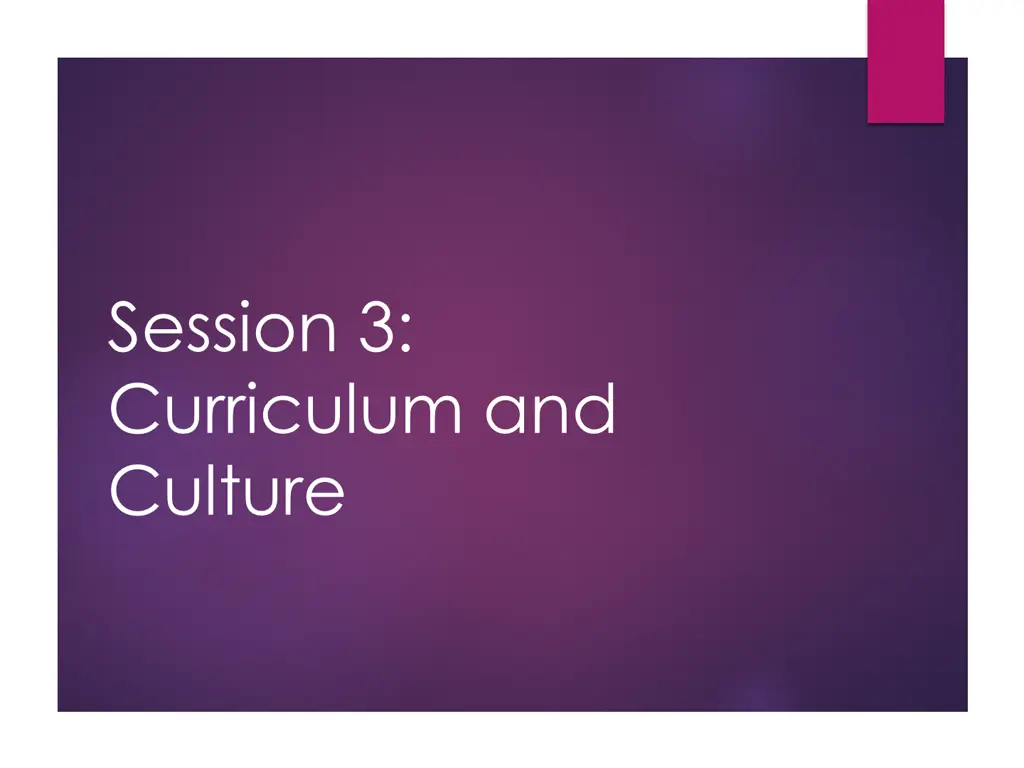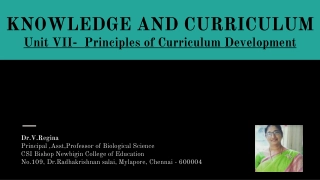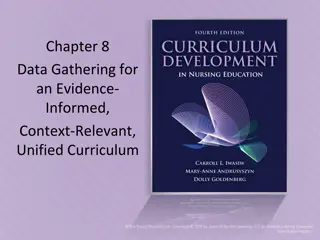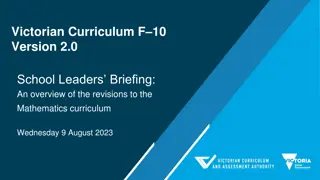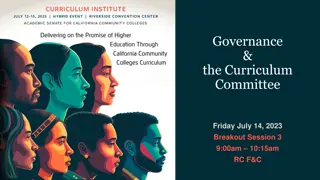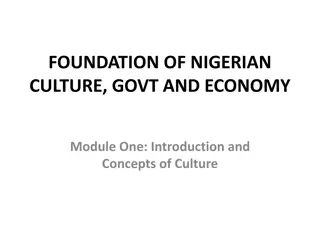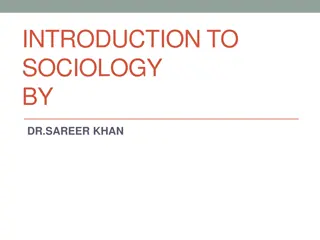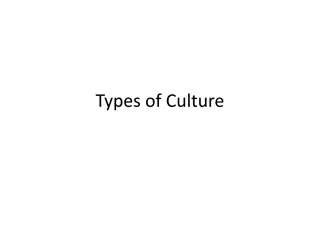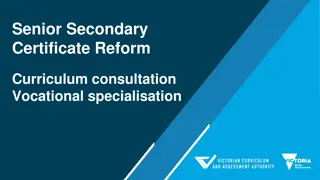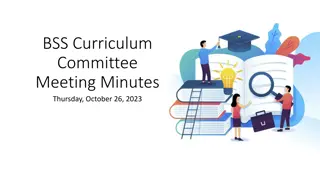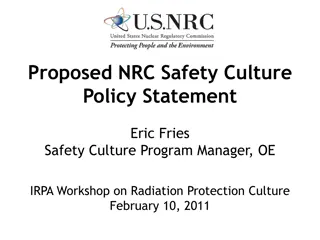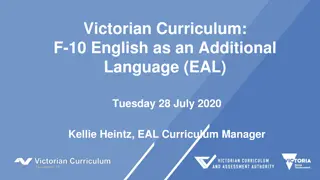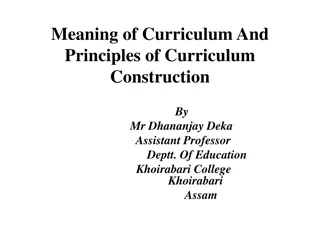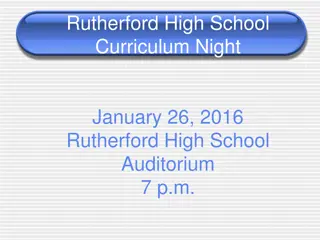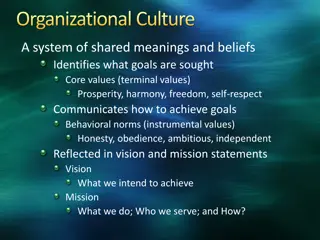Session 3: Curriculum and Culture
The complex relationship between curriculum and culture, including how culture influences curriculum production, the cultural messages within curriculums, and who is advantaged or disadvantaged by the curriculum.
Download Presentation

Please find below an Image/Link to download the presentation.
The content on the website is provided AS IS for your information and personal use only. It may not be sold, licensed, or shared on other websites without obtaining consent from the author. Download presentation by click this link. If you encounter any issues during the download, it is possible that the publisher has removed the file from their server.
E N D
Presentation Transcript
Session 3: Curriculum and Culture
Outline What is culture? What is the relationship between curriculum and culture? How are the two related? Where can culture be found in the curriculum? Equality dimensions to culture and the curriculum
Key issues The complex relationship between culture and curriculum 1) The ways in which culture is implicated in the production of curriculum 2) The cultural messages curriculums send out (hidden/explicit) 3) How curriculum is experienced, who is advantaged/disadvantaged? Whose culture is included/excluded?
What does culture mean? Values? Attitudes? Beliefs? Norms? Expectations? Dispositions? Culture = social class? Culture = religion / national identity / ethnicity? High ? Popular ? Tastes? Art? Music? Drama? Gender? Global international cultures? Past or present? Money / wealth? What has culture looked like in the different settings in which you have taught/lived?
Theorising culture: cultural, social, symbolic and economic capital (Pierre Bourdieu) Cultural capital: broad array of linguistic competencies, manners, preferences and orientations, subtleties related to culture/language 1) Embodied in mind and body: socialised from early childhood, sensitised to cultural distinctions 2) Institutionalised form (such as educational qualifications) 3) Objectified through cultural goods/artefacts, such as books, paintings, music, fashion, style, architecture, design, technology.
Other forms of capital Economic capital = wealth Social capital generated through social processes between family and wider society and is made up of social networks Symbolic capital = individual prestige and personal qualities (charisma, authority etc.) Conversion of differing capitals (economic to cultural, social to economic, cultural to social etc.)
Social class and forms of capital Different fractions of the social classes hold differing forms and volumes of these capitals Students from lower socio-economic groups appear to be guided from an earlier age, by reason of habit, culture and professional or peer expectation, to anticipate initial entry to the labour market rather than higher education. (Robertson & Hillman, 1997)
Dennis Lawton on culture Lawton defines culture as everything that created by humans in society. It includes tools, technology, language, literature, codes, laws, attitudes, values, etc. i.e. both concrete and abstract artifacts the whole way of life of that society.
Culture and curriculum Denis Lawton suggests the curriculum is: A selection from the culture of a society. The role of curriculum and schooling in society: Certain aspects of our way of life, certain kinds of knowledge, certain attitudes and values are regarded so important that their transmission to the next generation is not left to chance in society but is entrusted to specially-trained professionals (teachers) in elaborate and expensive institutions (schools) (Lawton, 1975)
Culture and curriculum Further, any curriculum planning should be preceded by cultural analysis (i.e. applying values to the culture of a particular society at a particular point in time, in order to arrive at a list of cultural priorities for schools to deal with by means of the curriculum).
Lawtons cultural universals Socio-political system Economic System Communication system Rationality system Technology system Morality system Belief system Aesthetic system
Some questions (How) are these cultural universals evident in the curriculum? What about cultural variables ? What happens when there is more than one set of universals or variables ? Are all the universals represented in the formal curriculum? How else do schools communicate culture?
Issues for further consideration How valid is Lawton s common culture curriculum idea? Can curriculum ever be culturally neutral (How) can educators/schools deliver more inclusive curriculums (both official and unofficial)? To what extent are official curriculums adaptable to difference?
Culture and curriculum Advocated a common culture curriculum All children should have access to the same knowledge (irrespective of class, culture, background) Classless nature of knowledge (q.v. Bernstein and Bourdieu) Importance of not denying knowledge to children (entitlement curriculum)
Some issues Can societies be characterised in this way (cultural universals). Is it a realistic depiction? (How) are these cultural universals evident in the curriculum? Is a common culture curriculum possible? Can curriculum really ever be free from class and culture? Lawton developed his framework in a largely monocultural society (1970s, UK); how applicable is it today and in contemporary societies?
Culture and the hidden curriculum School architecture, classroom design and organisation (for example, authority relationships) School time and timetables (Ball) Teacher expectations and interactions: gender roles; career guidance/educational destinations (Gillborn and Youdell 2000) Textbooks, displays and other artifacts (Apple) Social organisation of schools: pupil characteristics, dispositions (Ball)
East is East, West is West George Walker (2010) identifies four areas for potential value conflicts: A concern for the group rather than the individual Respect for authority A holistic view of the world Aversion to risk Link
